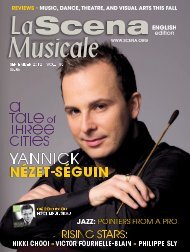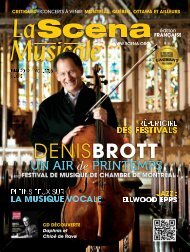The Bohlen-Pierce system - La Scena Musicale
The Bohlen-Pierce system - La Scena Musicale
The Bohlen-Pierce system - La Scena Musicale
Create successful ePaper yourself
Turn your PDF publications into a flip-book with our unique Google optimized e-Paper software.
JAZZ REVIEWS<br />
Out of the Cool and into the Hot<br />
by MARC CHÉNARD<br />
Of all the ways to classify jazz, the temperature metaphor (cool versus<br />
hot) is commonly used by critics and music-lovers alike. It may well be<br />
inadequate, subjective as it is, but at the very least it distinguishes<br />
between musical processes, separating those more contained in their<br />
dynamics and others more resolutely energetic and intense. Here are<br />
two groups at opposite ends of this thermometric scale, both of which<br />
will be appearing on local stages early this month. Given the nature of<br />
these two extreme examples, it is hard to imagine a listener who would<br />
enjoy both equally, but then again it way well be that some who like it<br />
hot may well dig it cool, too.<br />
Vincent Gagnon: Himalaya<br />
Effendi FND117<br />
Quebec pianist Vincent Gagnon presents, in his<br />
sophomore effort on Montreal’s stalwart jazz<br />
label, a ten-track, 46-and-a-bit-minute program.<br />
Of the pieces, two are by the leader, another pair<br />
is credited to alto sax player Alain Boies, one cut<br />
is penned by the other sax player Michel Côté,<br />
and a final one is by percussionist Michel <strong>La</strong>mbert;<br />
the remaining tracks are concise group improvisations<br />
for trio (“Débâcle,” 1:16) and quintet (“Perdide,” 4:09).<br />
An advertisement included with the disc describes its contents as<br />
“inspired and melodic jazz.” <strong>The</strong>se few words are enough to give the<br />
astute listener a good idea of the product. Lyrical and free of excess,<br />
this disc altogether is totally in keeping with the jazz aesthetic prevailing<br />
in the province’s capital. Even when it falls into a firmer swing,<br />
for instance in the bluesy “Anitaville” with its Monk-like strains, the<br />
dissonances so typical of the Master are toned down, while the soloists<br />
play well within their capabilities. But when the performers allow<br />
themselves a little more daring, as they do in the two group pieces, they<br />
do so furtively and far too shyly to leave a mark on the listener.<br />
Metaphorically speaking, this music is somewhat like a nicely groomed<br />
hairdo where any stray locks are hardly visible or deftly hidden beneath<br />
a collar. No doubt the pianist is fond of the ECM aesthetic—and this<br />
record bears its imprint, for better and for worse.<br />
• In concert on April 4, 27 and 28. (See Jazz+ calendar for times and places.)<br />
Ballister: Mechanisms<br />
Clean Feed CF245CD<br />
If Gagnon’s music flows as peacefully as a quiet<br />
brook, Dave Rempis’s will knock you over with<br />
the force of a flash flood from the very first notes<br />
of “Release Levers”, one of three long-winded,<br />
cutting-edge group improvs of 20, 16 and 28<br />
minutes respectively. If the previous disc’s music<br />
was clean cut all the way, this one really shears it<br />
off. Let there be no doubt here that this tenor and<br />
alto sax player draws inspiration from the dense, vibrant urban environment<br />
of Chicago, known for its gritty blues and experimental post<br />
free-jazz scenes. Some will recognize Rempis from his supporting role<br />
in the Vandermark Five—likewise for the cellist heard here, Fred Lonberg-Holm—<br />
the pugnacious Norwegian drum wizard Paal Nilsson-<br />
Love stoking the fires. This trio pulls out a lot of stops, and their<br />
recording is very much in the lineage of a now “classic” free-jazz style,<br />
with long, explosive passages that cool down just long enough for listeners<br />
to catch their breath before the next eruption. <strong>The</strong> titles of the<br />
other pieces (“Clapstock” and “Roller Nuts’) link to the album title,<br />
Mechanisms. While listening to these gentlemen go all out, one can<br />
only think of the grinding gears of heavy machinery. Seen in this light,<br />
the music also bears similarity to styles as ear-shattering as metal or<br />
punk rock. While it takes a lot of stamina to sustain full throttle<br />
assaults like these, a certain (if not unavoidable) degree of aimlessness<br />
ensues when playing hell-bent for leather at all times, and no onslaught<br />
of rapid-fire gestures can ever make up for a lack of conceptual design<br />
and artistic purpose stemming from it.<br />
• In concert on April 7. (See Jazz+ calendar for time and place.)<br />
TRANSLATION: ARIADNE LIH<br />
BOOK NOTES AND BLUE NOTES<br />
by FÉLIX-ANTOINE HAMEL<br />
Guillaume Belhomme :<br />
Way Ahead - Jazz en 100 autres figures<br />
Le mot et le reste, 2011, 435 pages<br />
ISBN: 9782360540174<br />
In 2009, Le Mot et le reste, a Paris-based<br />
publisher, issued a book by Guillaume Belhomme,<br />
an attuned contemporary jazz and<br />
improvised music critic for Jazz Hot and Les<br />
Inrockuptibles magazines and the Le son du<br />
grisli blog. <strong>The</strong> book, entitled Giant Steps—<br />
Jazz en 100 figures, is a practical guide to<br />
jazz consisting of 100 portraits of jazz’s most<br />
famous musicians, organized according to<br />
year of birth, an original touch—ranging<br />
from King Oliver to Ken Vandermark. This<br />
formula of short biographical notes followed<br />
by a selection of five important albums<br />
(complemented by additional recommended<br />
listenings), was taken up again last<br />
year with Way Ahead—Jazz en 100 autres<br />
figures. While its predecessor was first and<br />
foremost a guide to the basics, this sequel<br />
turns out to be a fascinating effort not by<br />
virtue of form or style (Belhomme’s syntax is<br />
frequently irritating), but by the choice of<br />
featured musicians. While a good third of it<br />
is devoted to musicians who could have<br />
appeared in the first volume (i.e. Benny<br />
Carter, Teddy Wilson and Zoot Sims), the<br />
rest of it is devoted to iconoclasts, originals,<br />
musicians confined to the margins of jazz<br />
history, the likes of Pee Wee Russell, Herbie<br />
Nichols Anthony Ortega among others. Belhomme<br />
is surely a<br />
devotee of free<br />
improvisation and<br />
his choices among<br />
younger musicians<br />
certainly reveal his<br />
preferences, but this<br />
editorial decision has<br />
the virtue of giving<br />
an added angle to the<br />
book, namely, to<br />
present a good introduction<br />
to some musicians<br />
about whom little French-language<br />
literature exists. In fact, an English translation<br />
of this book would be also very welcome<br />
for its updated focus on the music.<br />
LSM<br />
TRANSLATION: ARIADNE LIH<br />
18<br />
APRIL 2012

















